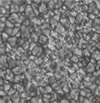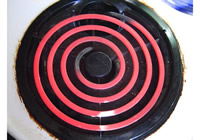Heat Transfer
Heat is a synonym for thermal energy which, as we have mentioned before, is really kinetic energy in disguise. It's the kinetic energy of moving atoms and molecules. On average, in a hot material the atoms and molecules are moving faster than in a cold object. Temperature is a measurement of the average kinetic energy of the particles; we could, if we wanted, use Joules to measure temperature. Of course, those numbers would be very small, and so the Celsius and Kelvin scales are much more convenient.
Left all to itself, a hot material will transfer thermal energy to colder material. We call this heat transfer, and it happens in three basic ways: conduction, convection and radiation.
to do as you read
Conduction is heat transfer by touch. If a hot object is touching a cooler object, the hot object's fast-moving atoms bump into the cold object's slow-moving atoms. Any given atom will experience billions of collisions per second. Each of these collisions is elastic, and in general the slow-moving atoms will gain kinetic energy at the expense of the fast-moving atoms. Conduction is the mode of heat transfer you experience whenever you touch something and you feel it is hot or cold. For example (in order of increasing foolishness):
- you burn your mouth on a hot slice of pizza
- you walk across hot asphalt with bare feet
- you touch a hot lightbulb
- you stick your fingers into a toaster and burn them on the heating coils
Convection is heat transfer by fluid motion. As we discussed a few days ago, when a material is heated, it expands. Mostly we were talking about solids, but the same thing happens to fluids (liquids and gases). When a material expands, it becomes less dense. In the case of a fluid that is heated, the heated fluid is less dense than the surrounding fluid, becomes buoyant and rises. The rising hot fluid carries its thermal energy with it. As hot fluid rises, so must the cooler fluid sink. This pattern of rising hot fluid and sinking cold fluid is called convection. You have experienced convection in your life by watching...
- Candle flames point upwards because the hot air rises, stretching the flame in that direction.
- A pot of water on a hot stove, perhaps with spaghetti that reveals the currents of water
- A hawk or other large bird, circling gracefully overhead without having to flap its wings: hot air near the ground rises, and the bird takes advantage of these so-called "thermals" to stay aloft without having to work at it
- Large puffy white clouds, or perhaps dark thunderstorn clouds: these form when rising hot air cools due to the reduced pressure at high altitudes — when it cools enough, water vapor condenses into droplets, making a cloud
- "Ripples" above a hot road surface on a sunny day, over the hot hood of a car after a long drive, above a campfire, or over a heater or stove in your home. Below is a short video (on the left) of my kitchen stove, with a morning sunbeam passing above the hot electric stove coils nicely highlighting the turbulent, convecting air.
- The surface of the Sun, examined closely through a (safely filtered) telescope, appears granulated, like a bowl of sugar. Each "sugar grain" is a convective bubble of hot rising gas, about a thousand kilometers across. Here (below right) is a short video snippet showing the motion. The square is 22,000 km on a side, about 0.03% of the Sun's visible surface.
Radiation is heat transfer by light. All objects radiate (send outwards) energy in the form of electromagnetic waves, which is just a fancy phrase for light. In other words, everything glows. Some forms of light, such as infrared light, are not visible to the human eye but carry energy just as visible light does. You yourself glow, but all in infrared, so you don't see it. Objects that are hot enough, such as toaster coils, lightbulb filaments and stars, glow with visible light. You have experienced heat transfer by radiation countless times in your life, such as when
- warming yourself on a cold but sunny day by stepping into the sunlight
- holding your hands to the side of a campfire or fireplace
- eating food at a cafeteria or fast-food restaurant that was kept warm with heat lamps (bright lights shining down onto food that is prepared but waiting to be purchased)


